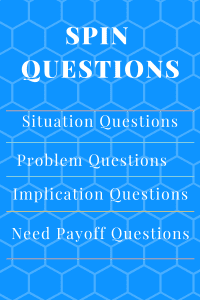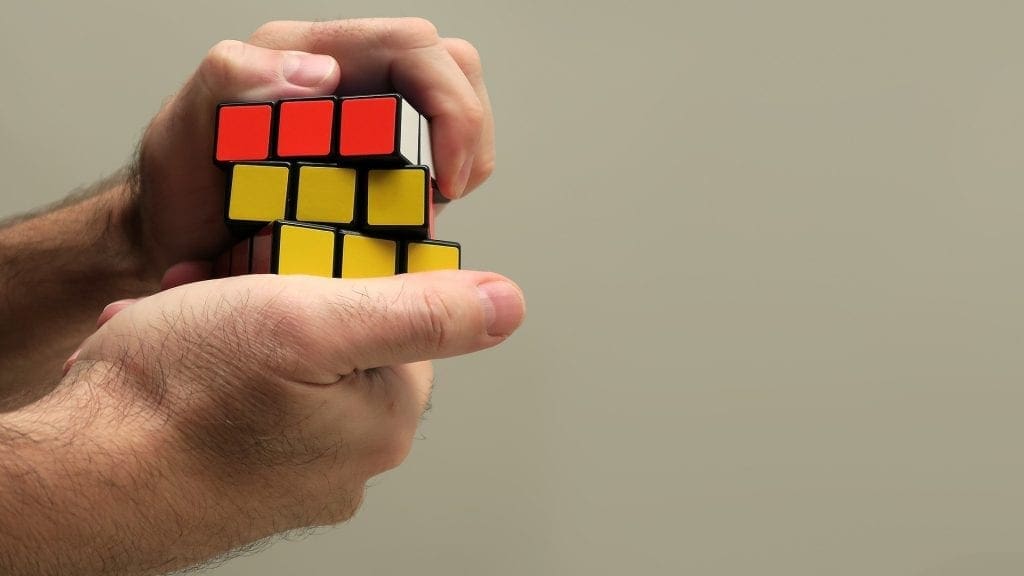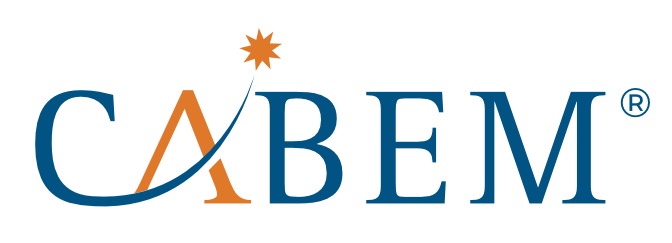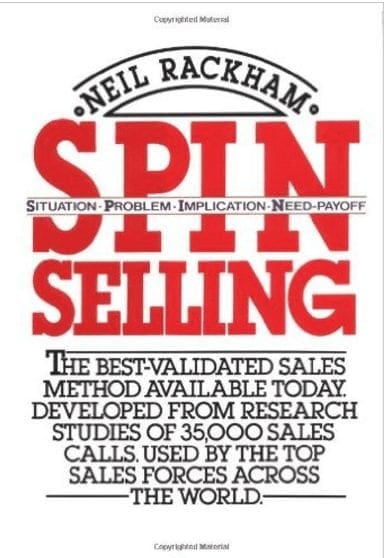Introduction to SPIN Selling
Nowadays there are countless sales books, videos, and more that promise to teach you how to be a better salesman. I’ve read plenty of them and I’m sure you have too, but one of the best ones that have stood the test of time is “SPIN Selling” by Neil Rackham.
Personally, this book has helped me tremendously in my sales and marketing efforts. And after going through all of my notes, I felt I should turn them into an article that would be helpful to people, whether they are involved directly with sales or not. And at the very least, save you the time it would take to read the whole book!
Even though SPIN Selling is an older sales book, it is still relevant because of its unique approach and backstory. Neil Rackham is not a salesman in the traditional sense, he is a researcher and consultant. From the ‘70s to ‘80s his company embarked on a 12 year, 1 million dollar research study to determine what resulted in the most effective sales performance. The hours and hours of studies, interviews, and research with different companies were distilled into a very simple model of questions that successful salespeople asked in larger sales, which he called SPIN Selling. SPIN stands for:
- Situation
- Problem
- Implication
- Need Payoff
And in his research, he also found out that there were clear differences in sales calls depending on the product sold. He made a distinction between complex, larger sales, and simple, smaller sales. The SPIN Model applies to complex sales.
Complex Vs. Simple Selling: How Are They Different?

(Image Source / Neil Rackham)
Traditional sales techniques are good for simple sales (usually one call and a lower dollar amount) but do not work well for complex (multiple calls, large dollar amount) sales. This is for a variety of reasons, but two main ones are that complex selling requires buy-in from multiple stakeholders in the purchasing decision. Because of this, the seller engages in many phone calls and meetings that involve not only discussing the product or service but also about building relationships, as he or she will be working with people in that company for a long time if the sale is made.
And not only that, but another important distinction is that most of the dialogue does not occur during these calls at all, as it does in small sales, but internally between stakeholders of the organization after the sales calls. The sale is really made when the salesperson is NOT in the room, but when the company employees discuss among themselves and agree to buy. For this reason, a salesperson must arm their prospect with the tools to sell to their own coworkers.
In addition to these major differences, keep in mind that the SPIN Selling model is not a rigid formula, it’s more like a road map. While the sales calls should loosely follow this structure it may not always, so do not view this like a checklist that must be done in a specific order all the time.
What Are the SPIN Questions?

The different stages of SPIN are defined as:
S (situation)
Asking about the current state of the company to get context on their responsibilities, processes, tools, objectives, and more.
P (problem)
Asking questions that allow you to identify any current problems the organization is having and start to formulate their specific needs.
I (implication)
Asking leading questions related to the problems discovered in the last stage. These questions will magnify these problems and uncover how they can negatively affect the organization.
N (need payoff)
This is the opposite of the implication stage. It involves asking questions about solutions. The seller will uncover how solving the problems identified will benefit the organization. If all of the stages are executed properly, the prospects will even tell YOU how your product or service can help them.
It is difficult to think of questions for all of these stages on the spot. Instead, prepare yourself in advance. Before every sales call, write down three problems the customer might have that you can solve, and three examples of problem questions you can use to discover them. For specific examples of these types of questions and more info, go to the corresponding section below.
But sales calls or meetings do not consist only of the seller asking questions. In the book, Rackham outlines four major stages of a sales call, including when to ask the SPIN questions.
Four Stages of a Sales Call
Preliminaries

This is where the stakeholders for the vendor company and the potential customer meet. According to Rackham, don’t be afraid to get down to business in this selling stage. While spending a minute on pleasantries is okay, spending too long does not correlate to more successful complex sales. Instead, a better way to open larger calls is to go over the objective and establish your role as the seeker of info. Outline expectations so the customer feels comfortable from the beginning in providing information and answering lots of questions from you.
Investigation (the SPIN stage)
The key to this stage is to remain focused on one thing – asking questions. This is the stage where you will go through the SPIN model by asking situational, problem, implication, and need payoff questions.
In this stage do not focus on what you will tell the customer about your solution. This comes in the next stage. Always keep in mind that if you’re getting too many objections early on in the call, it means you’re not asking enough questions. Simply wait longer to offer a solution and ask more questions to fix this.
Demonstrate Capability
This is the stage most salespeople rush into, which is showing what your product can do and why it is a great solution for the customer. In the book, Rackham states that a benefit “should show how the solution meets an explicit need expressed by the customer.” Only discuss features and aspects of your product that directly address these explicit needs you learned about from your SPIN questions.
Do not talk about all of the ways the product can be used or all of its features, because at this point the customer does not care. This will only detract from what he or she wants to hear, which is how it will solve the specific problems that were expressed. And always keep in mind that value to the customer is so much more important than any specific feature or capability.
Obtain Commitment

Lastly, a successful sales call results in a commitment from the customer. Rackham is very specific about how he defines a commitment. Four clear actions he outlines to gain commitment are:
- Give attention to investigating and demonstrating capability.
- Double-check that key concerns are covered and ask lots of questions.
- Summarize key points and benefits of the discussion right before moving to commitment.
- Propose a commitment and suggest the next step.
And the four types of results in complex sales are:
- Orders: This is when the customer makes a purchase and is a successful sales call.
- Advances: This is when you set objectives for specific actions (such as schedule a next meeting) and is also a successful call.
- Continuation: This is when the parties make an informal agreement to talk in the future, this is not a success.
- No sales: If the prospect has no need for the product, this is also an unsuccessful call.
In simple selling, closing is the most important aspect, and you can try many types of established closing techniques to get this result. But with large, complex selling, it is different. Rackham showed that high numbers of closes in large sales led to fewer wins. Once again, it is crucial to stick to asking questions and gaining information at first, not attempting to make a sale.
And lastly, the best salespeople review the calls after they made them recognize what worked, what didn’t, and adjust accordingly. The best salespeople understand the key to success is in the details of knowing what to ask and what you are going to do before the call even starts.
Examples of the SPIN Questions
Below I’ve outlined what the four SPIN stages are, as well as specific examples of questions you can use during each. Keep in mind these questions should be flexible and change depending on the context of each call!
Situation Questions

Situational questions help set the stage for the rest of the call and are how you learn basic information about the customer. Don’t spend too much time here, as too many situational questions lead to failure. Ask just enough to set up the next stage, problem questions, which should be used more often.
Examples of Situation questions include:
- What is your current role?
- Tell me about your day-to-day duties?
- How many locations do you have?
- How many individuals and/or teams do you oversee?
- What is your current process?
- Which software platforms and tools do you currently use?
- How long have you been using these tools?
- What is your current budget for a replacement?
Problem Questions

This is where you identify the prospect’s current problems. A simple method is to ask, “What are the issues with your current process?” Keep in mind that in large, complex sales, it is rare that your solution will solve every problem the company has, but customers don’t expect this anyways. They want the main problems to be solved, and at a reasonable cost.
Many salespeople discuss features and details in small sales – do not do this in large sales. Customers don’t care about the features at first, they care if their problems will be solved.
In the problem stage, the successful salesperson is a detective and does not go into a sales call assuming to know all of the problems, but instead to ask the buyer questions to uncover them. As the buyer answers the more general problem questions, the seller can ask more specific questions to uncover deeper issues the company is currently facing.
Examples of Problem questions include:
- How satisfied are you with the current way of doing things?
- Are there any problems with how things are done now?
- How many people are required to do the job with the current process?
- How long does it take you to do the job now?
- Is it too costly to complete an average job?
- If you had to solve one problem you have now, what would that be?
Implication Questions

This is arguably the hardest but most important stage of the call. This is where you expand on the problems you identified, and ask follow-up questions to magnify them for the customer. Ask lots of “What if” questions in this stage. It is crucial to not offer a solution to the customer until the need has been built up to be strong enough, otherwise, you will face objections.
Implication questions are problem-oriented, while need payoff questions (the next stage) are solution-oriented. It is difficult to come up with these types of questions, and they likely won’t come into your head during the call, so make sure to plan them in advance. A helpful technique Rackham gives is to imagine the customer objecting to you, saying “so what, I have these problems, but they aren’t that serious.”
This will force you to think of answers to these questions and uncover the deeper problems underneath. In many cases, potential customers can identify their problems but are so entrenched in their day-to-day activities they do not realize how much of their process is built around these problems. As you ask probing questions, the customer will have “lightbulb moments” and see how a problem that seems small leads to other problems throughout the organization.
Simply uncovering problems does not make a successful call though. All employees have problems. You need to grow those problems until the customer is talking about action and is saying things such as “I’m going to overhaul our program next year.”
Examples of Implication questions include:
- If you spend too much time on (duty they mentioned), what other duties are overlooked?
- Are there any business goals or KPIs you have missed because of (current problem identified)?
- If there is a problem with (necessary duty), how long does it take to fix this issue?
- Have you ever lost a customer because of the current process?
- In recent memory, what issues have been caused because of your current process?
- Have you gone over budget because of the current (too costly or timely) way of doing things?
- How does (the current situation) affect your personal career growth?
- If (day-to-day duty) doesn’t happen, what is the result?
- Does (prospect’s problem) affect the duties of your superiors or other team members?
Need Payoff Questions

This is an often overlooked, but crucial stage in the sales call. Rackham proved in the SPIN Selling book that top salespeople ask 10x more need payoff questions than average. So ask as many as you can, maybe even more than you think is necessary! This is when you talk about solutions to the problems you have identified. Ask questions that start with “If you could” or “Would this help?”
When the customer raises needs, most sellers talk about their solution (product or service). But this is when you should ask need payoff questions because you get them to realize how they would benefit from having the identified problems solved. Remember, the prospect does not care as much about features, only benefits and value to them.
Need payoff questions are so important because they focus the customer’s attention on the solution rather than the problem. Up to this point, you have been identifying problems and magnifying them. The customer has a negative viewpoint, and this is where you take the opportunity to turn their thoughts positive and be the solution! If done effectively, the customer will actually describe the solution to you and how you can solve their problems.
In the book, Rackham tells an anecdote, of a successful millionaire dollar salesman. The man said it’s important to keep in mind that you (the seller) are only a small part of the selling. He recommends thinking of a sales cycle like a play. Most salespeople think they should be great actors, but they need to be great directors, meaning they are influencing other people to carry out the goal.
The key to this is in the need payoff questions because it helps the potential buyer think deeper about what their needs really are. As mentioned before, most of the selling really occurs between your contact and other key decision-makers in the company. Need payoff questions are valuable because there is no way any prospect can be an expert in your product with one or two calls. But if he or she can recognize the needs that the product solves, he or she can accurately describe its benefits to other people in the organization. In this way, your contact is an asset in selling to key stakeholders, even though you may not talk to them directly as often.
Examples of Need Payoff questions include:
- How would that help?
- Why is that important?
- What benefit do you see in (eliminating the current problem)?
- If you could easily solve (identified problem) how would that help you achieve your current goals?
- If you could save time on (current situation), how would that help you?
- What could you do with the extra time you have saved?
- Would (eliminating the current problem) save you money?
- Why is (an action that accomplishes a goal) important to you?
Now Start Selling!
via GIPHY
Now that you have the knowledge of decades of selling experience, it’s time to go out there and start selling! Keep in mind that following the SPIN model is easier said than done, so be sure to practice scenarios on your own, and properly prepare for any upcoming calls. Good luck!

